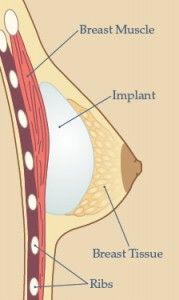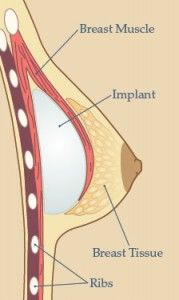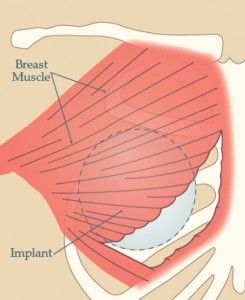Best Breast Implants – Augmentation Approaches
Dr. Mark Mitchell Jones of Atlanta Plastic Surgery Specialists has combined the best aspects of the different augmentation approaches to develop his unique approach to breast implants and breast augmentation surgery. To understand how Dr. Jones is able to accomplish such an exceptional outcome, it helps to understand some key choices a surgeon makes as he or she performs breast augmentation surgery. Where and how the surgeon places the breast implant determines how it will look and feel, and for how long it will look good.
The implant can be placed either on top of the breast muscle and below the skin and breast tissue (Figure 1), or behind the muscle in a pocket against the rib cage (Figure 2a for a side view and 2b for a frontal view).
 |
 |
 |
- Sub Glandular Breast Implant Placement (On Top of the Muscle)
- Placing the implant on top of the muscle (Figure 1) will give a full, round look with more cleavage. However, the implant will likely sag over time as the skin stretches with no muscle support (recall that the implant is ‘on its own’, the muscle resting behind it). Most silicone implants are placed in the pocket in front of the breast muscle.
- Figure 2a
- Sub Muscular Breast Implant Placement (Behind the Muscle)
- Alternatively, when the implant is placed behind the muscle (Figures 2a and 2b), it gives the breast a more natural feel and less upper bulging. Why? Because the muscle around the implant now supports it, leaving the breast tissue untouched. This approach maintains a more natural look and feel for the patient, yet with a larger breast size. Saline implants are typically placed behind the breast muscle.
- Figure 2b
- Breast Augmentation Incision and Pathway Options
- The next question beyond where to place the implant is how to get it there; in other words, where to make the incision and what pathway to use to get the implant in its place. In the first case, when the implant is placed on top of the muscle, the surgeon can make the incision in the crease fold under the breast, in the armpit, around the areola (dark area around the nipple), or in the belly button. If the incision is made in the belly button, the surgeon has to use a metal (or some other material) pipe to create a pathway to place the implant in its proper position on top of the breast muscle. Otherwise, the process is straightforward. The surgeon manually squeezes the implant through an incision in the breast area to lay it on top the breast muscle. There is no muscle cutting or resultant bleeding involved when pushing the implant through the breast tissue, or when manipulating it into its proper form inside the breast in front of the muscle. However, in the end, there is but minimal support and coverage for the implant from the skin and breast tissue.
- Figure 3
- Optimal Placement of the Breast Implant
 |
- Placing the implant behind the muscle poses further challenges. This is where an excellent surgeon rises above your average surgeon by minimizing cutting the muscle and by knowing how to manipulate the implant into its most optimal position and shape for permanence. In most cases, to place the implant behind the breast muscle, the surgeon has to cut through either the muscle fibers or the fascia that connects the muscle to the rib case (Figure 3), weakening the support below the implant, and thus promoting droopiness and bottoming out. Why is minimizing cutting the muscle so important? First, cutting the muscle causes bleeding, which in turn results in internal scarring and potential hard spots that may look lumpy and feel painful. Second, cutting and scarring the muscle weakens it. This increases the likelihood of the implants sagging in the long run, because the weakened muscle has to support a heavier breast.
To fully appreciate Dr. Jones’ superior technique, it is important to recognize that when most surgeons talk about placing the implant behind the muscle, they are not really talking about placing the implant all the way behind the muscle, but rather into a pocket created by splitting the breast muscle from the bottom attachments where the muscle tissue is the thinnest (Figure 2). As a result, the implant is supported by breast muscle on the top, the front, and the back, but the bottom—the pocket opening—leaves the implant bottom resting on a thin layer of breast tissue and skin. In the long run, gravity will naturally cause the implant—without muscle support on the bottom—to sag. Also, when creating the bottom-holed pocket for the implant, the surgeon has to cut some muscle, making some bleeding and scarring inevitable.
Types of Breast Implants
The type of breast implant used is also an important factor in terms of the final outcome of breast augmentation surgery. During your initial consultation, Dr. Jones will go over the different types of breast implants with you, and recommend the most appropriate type to help you achieve your desired outcome. If you would like to schedule a breast augmentation consultation with Dr. Jones, please contact our Best Breast Implants – Augmentation Specialists today.